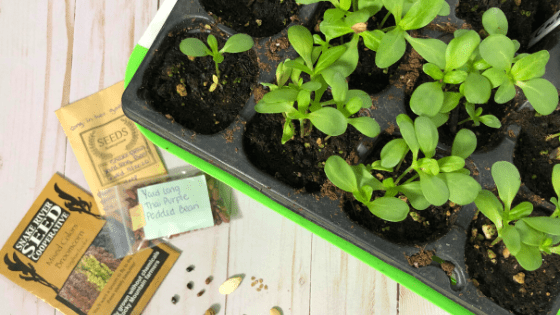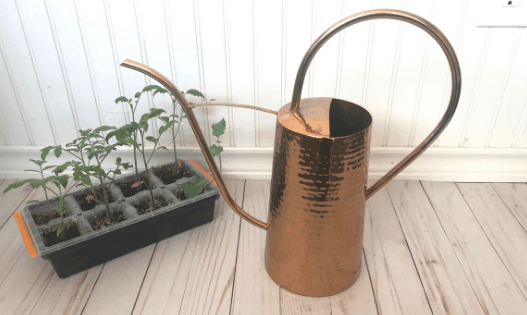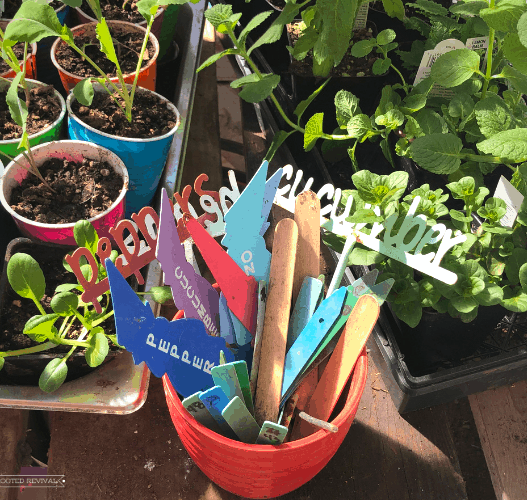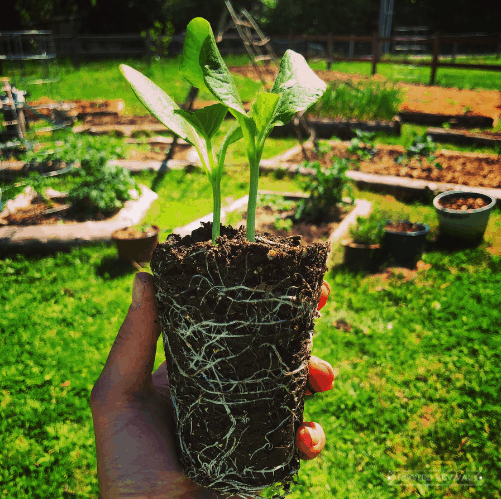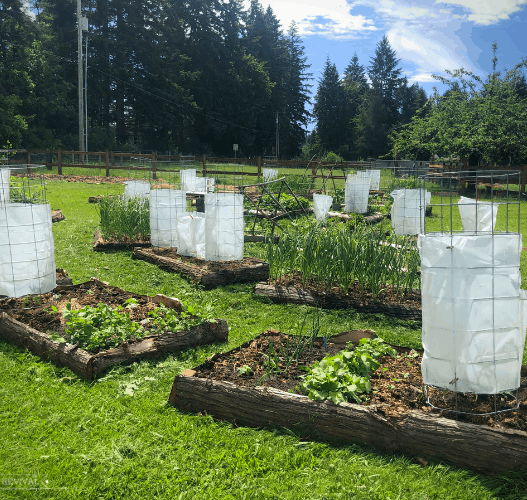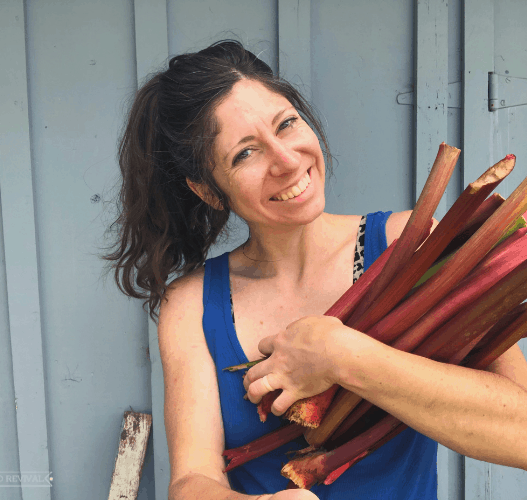Sowing seeds is fairly straight-forward, but there are some important things to know for more successful germination. Here’s the full scoop on how to sow seeds in trays or containers!
For many years, I would head to the nursery each spring and purchase a cart-full of veggie starter plants. I would bring them home, plop them in the ground and that would be our garden for the year. But, as I became more garden-obsessed and our garden expanded, I realized that buying starter plants was going to cost more than we could afford! My choices were to keep the garden small or learn how to grow my own plants from seed.
Well, obviously, this girl couldn’t manage to keep her garden small! So I became a seed starter!
And, let me tell you, learning how to grow my own garden plants was a major turning point in my gardening life! It took a few years to figure out my system and work out the kinks, but it was 100% worth every minute of effort!
Top 3 Reasons to Grow your Garden Veggies from Seed:
Save money:
It is so much cheaper to grow your plants rather than buy them as starts from a nursery! I talked more about this in my 2019 post “8 Ways We Saved Money On Our Homestead Last Year”. That year alone, we saved around $70 on JUST tomato plants compared to buying them at the nursery. And, the larger your garden gets, the more money you will save by growing your own plants whenever possible. I can only imagine how much we save now that we grow virtually all of our annual vegetables from seed!
More Variety:
During an average gardening season, I grow around 100+ varieties of veggies and herbs. Now, you might not need or want to grow that many, but growing your own definitely allows you to benefit from a diverse array of seed options! A lot of nurseries grow certain varieties based on their popularity in that area. This is great, but there are soooo many more amazing varieties out there waiting for you to try! One of my favorite parts of gardening is being able to try out new and unique foods and varieties that we’ve never tried before!
Security:
Have you ever been a week late getting to the nursery, only to find a sad selection of picked over garden veggies left? It definitely happens! And, as more people take up gardening, we are seeing more and more shortages. Learning how to grow your own plants from seeds will help secure your food harvest, regardless of what is happening in the world! It was so nice to not have to set foot in a garden center or nursery at all during the 2020 pandemic and still have a giant, lush garden! And, if you also start saving your seeds, then you are really setting yourself up for future success!
How to Sow Seeds in Trays
In my previous posts, we talked more in-depth about how to start growing your plants from seeds. In case you missed it, be sure to check out my other posts about choosing the right containers for your seedlings and making your own seed starting soil mix!
So, now that you’ve nailed down the correct containers and soil mix, it’s time to actually start planting those little seed babies!
Simple: You just drop some seeds in the soil, right?!
Well, kind of! The majority of garden veggie plants are super easy and straight-forward to sow. But, there are some things to keep in mind which will effect germination. Let’s chat real quick about the importance of seed depth and how many seeds to plant per cell/container.
You can also check out this video (originally posted as part of an Instagram IGTV series) for a better look at how to sow your seeds!
[mv_video doNotOptimizePlacement=”false” doNotAutoplayNorOptimizePlacement=”false” jsonLd=”true” key=”qvkoycdnagkb6r4zcfyz” ratio=”16:9″ thumbnail=”https://mediavine-res.cloudinary.com/v1617050945/sbvx0ewnr64y0igagbaf.jpg” title=”Seed Starting: Sowing Seeds” volume=”70″]
How deep to sow your seeds:
Not all seeds should be planted equally! Seeds are incredibly diverse and these differences mean that they all germinate and develop in different ways.
For the majority of garden veggie seeds, bigger seeds will be planted deeper than smaller seeds. Most are planted 1/4” to 1” deep depending on the size of the seed.
Most seed packets will tell you how deep to plant your seeds. If it isn’t listed on the packet, you can also check online. Or, as a general rule of thumb, most veggie seeds will be planted twice as deep as they are wide. That being said, it’s generally better to err on the side of planting too shallow rather than too deep.
Now, there are certainly exceptions to the rule. The most common exception is for “Light Dependent Germinators”, also known as “Surface Sown Seeds”. These are seeds that need to be placed right on the surface (covered by an extremely light dusting of soil at the very most) in order to germinate. These seeds are usually teeny tiny little seeds! Many herbs are in this category and lettuce seeds also generally do best when surface-sown.
There are many other seeds that require special germination conditions as well. These include seeds that need cold-stratification (a period of cold exposure) along with seeds that need scarification (scratching of the shell). There are even seeds that need to be digested by animals or go through fire in oder to germinate! But, luckily for the average gardener, most annual vegetable crops fall under the normal germination conditions.
How many seeds to sow per cell or container:
Now that you know how deep to plant your seeds, it’s time to get them in the soil! But, how many seeds should you place in each cell or container?
The general rule of thumb is to plant 2-3 seeds per cell/container. Planting more than one seed helps ensure germination. Since germination rates vary, you can’t always assume that every seed will turn into an adorable baby plant. Some of them just don’t make the cut!
If all of the seeds do germinate, you can carefully remove and pot the extras (bonus plants!) or just snip them off at the base near the soil line, keeping the largest/strongest seedling.
Overview: How to Sow Seeds in Cell Trays or Containers
- Fill your trays or containers with soil. You can get a more in-depth overview of this procedure in my post: All About Seed Starting Containers.
- Create an adequately deep depression in the middle of the cell (or container) using your finger or other tool (popsicle sticks and plant markers work well for this).
- Drop 2-3 seeds in the depression. Space the seeds slightly but keep them as close to the center of the cell (or pot) as possible. This helps the roots form centrally, which will make it easier to remove the plant when it’s time to pot up.
- Gently cover the seed with a layer of soil. Fine soil is best for germination as it makes it easier for the baby plant to push through the soil level.
- Mark your seeds and water them gently.
That’s it! You’ve planted your seeds and taken a big step towards food security! Woot!

